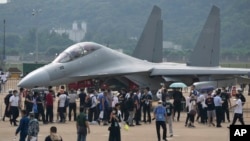Top U.S. defense officials admit recent Chinese military advancements, including the test of a hypersonic weapon system, are reason to worry, but the secretary of defense says if Beijing was hoping to intimidate or scare the U.S., that is not happening.
“America isn’t a country that fears competition,” Lloyd Austin told government officials and defense companies in a speech Saturday at the Reagan National Defense Forum in Simi Valley, California.
“We’re facing a formidable challenge,” he said. “And we’re going to meet this one with confidence and resolve — not panic and pessimism.”
During his speech, Austin addressed China and Taiwan, but he also spoke about Russia, which has tens of thousands of troops massed along its border with Ukraine.
The U.S. remains focused on Ukraine, he said, adding that Russia had invaded before, in 2014 when it annexed the Crimean Peninsula. The U.S. is making sure Ukraine has what it needs to defend its territory, Austin said.
On Taiwan, Austin said the U.S. is working to deter conflict, not change the status quo. He said the U.S. is seeking open lines of communication with China’s military leaders to prevent miscalculations.
Top U.S. military officials have repeatedly raised concerns for months, warning Beijing is “closing the gap” as it aims to surpass the United States as the world’s preeminent military power in the coming decade.
Washington’s most senior military officer, General Mark Milley, chairman of the Joint Chiefs of Staff, went as far as to compare China’s hypersonic test in July to Russia’s launch of the world’s first artificial satellite in the 1950s, which sparked the space race that dominated the next several decades.
“I don’t know if it’s quite a Sputnik moment, but I think it’s very close to that,” Milley told Bloomberg Television last month. “It has all of our attention.”
A Pentagon report released last month on China’s military power concluded that Beijing is “increasingly willing to confront the United States and other countries in areas where interest diverge,” and warned that China is likely to have at least 1,000 nuclear warheads by 2030.
Only Defense Secretary Austin, just back from a trip to Seoul where he met with his South Korean counterpart, has been seeking to lessen the anxiety that has been growing in Washington and elsewhere.
During a joint news conference with South Korean Defense Minister Suh Wook this past Wednesday, Austin called China’s hypersonic test “a capability but certainly not the only capability.”
“We have concerns,” he said, adding, “My job is to focus on the broader picture.”
In prepared remarks Saturday, Austin says the U.S. “has been stepping up its efforts” to counter China’s rise as a military power, looking to pour more money into research and development, and testing, of new systems that will allow the U.S. to be more lethal from afar.
He also says money is being spent on drone and stealth technologies, and efforts are being made to make sure existing weapons systems are more resilient, both the physical attack and attacks from cyberspace.
“When we maintain our technological edge, we maintain our military edge,” according to Austin’s prepared remarks. “The United States has an advantage that no autocracy can match—our combination of free enterprise, free minds, and free people.”
The Defense Department, under Austin, has also been emphasizing stronger ties with allies in the Indo-Pacific, something he emphasized during his visit to Seoul and in a subsequent phone call with his Japanese counterpart.
But he says the expansion of traditional alliances, and new efforts such as AUKUS (Australia, the U.K. and U.S.) and the Quad (the U.S., Japan, India and Australia), should not be seen as the first moves in a new Cold War, this time pitting Washington against Beijing instead of Moscow.
“We’re not seeking an Asian version of NATO or trying to build an anti-China coalition,” Austin said. “And we’re not asking countries to choose between the United States and China.”
“Instead, we’re working to advance an international system that is free, stable and open,” he added.
But some of the talks surrounding the strengthened U.S. alliances has rankled Beijing.
Earlier this week, former Japanese Prime Minister Shinzo Abe told a Taiwan-based research organization that a potential Chinese military attack on Taiwan would be “a major danger to Japan's territory… and therefore an emergency for the Japan-U.S. alliance.”
In response, China summoned Japan’s ambassador for an emergency meeting.
A statement from Chinese Assistant Foreign Minister Hua Chunying further criticized Abe’s remarks, saying they "openly challenged China's sovereignty and gave brazen support to Taiwan independence forces."




